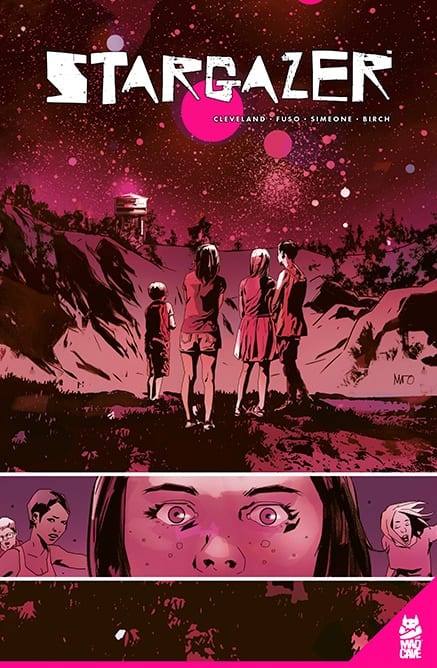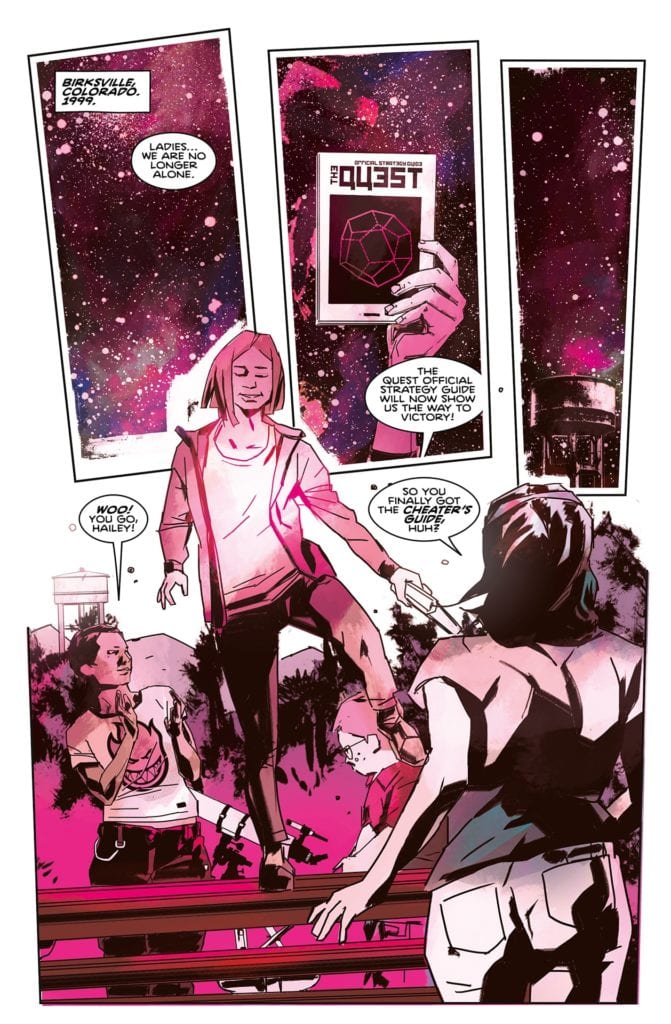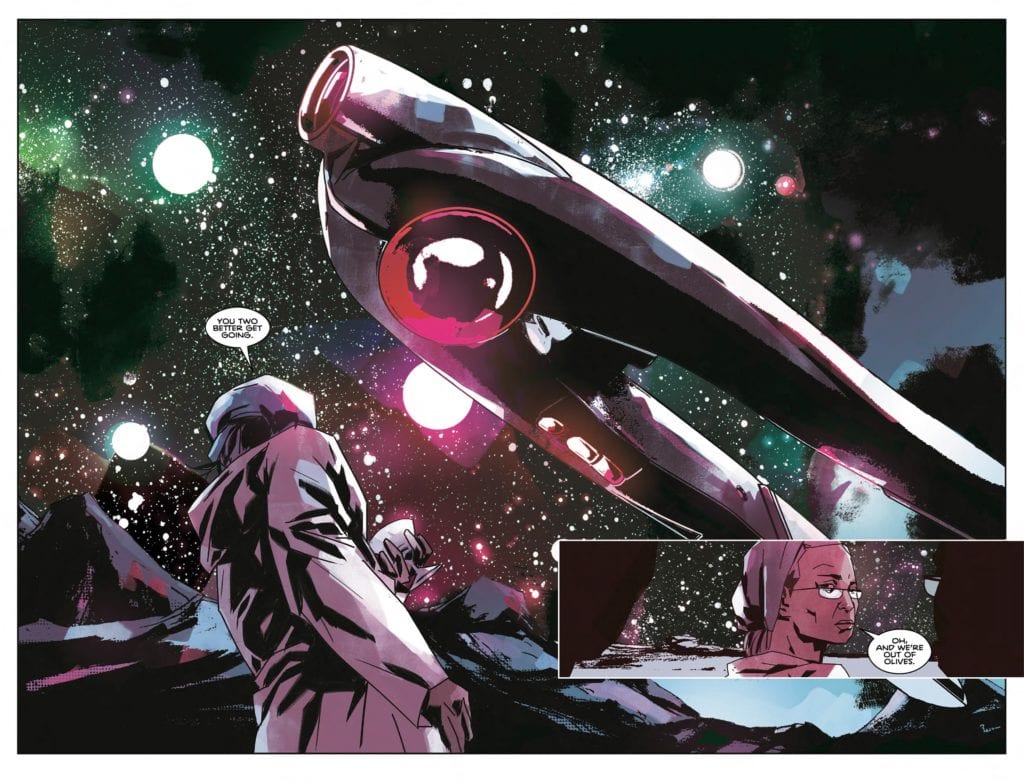When it comes to talking about comics, it’s all too simple to compare the narrative to other media (i.e. “If you like these films, you’ll love this comic”). And this is especially easy to do with a comic like Stargazer from Mad Cave Studios. In my review of issue 1, I compared it to the X-Files, Close Encounters of the Third Kind, and even Douglas Adams novels. The clichés of the Alien Abduction narrative form the backbone of Stargazer, and though some are universal to the point of tedium, “tedium” is not a word that you can associate with this story. Stargazer is a page turner — a visually engaging, often challenging, examination of friendship, family, and of course the mythology surrounding the obsession with Alien Abductions. It goes far beyond being a reflection of a movie or television show.
All of the original six issues are brought together in a single volume due for release on 28 April 2021. The book follows the story of four friends who were abducted by aliens as teenagers and as adults have to deal with the emotional and psychological fallout. The situation is made worse when it appears that the aliens are returning and the group are forced to face the truth about what happened to them years before.

Unidentified Flying Objects Sighted
The rotting corpse of a whale is found in the middle of a dessert.
As openings go, it’s a scene stealer. Writer Anthony Cleveland sets up the series perfectly with his opening gambit. He draws on tropes from the genre and creates a mystery that is fundamental to the plot without giving anything away. This mystery weaves throughout the chapters and infects every aspect of the narrative. Each of the major arcs contains a mystery that needs to be solved in order for the arc to end, and this narrative layering keeps each chapter fresh. Yes, you can draw parallels with the X-Files, but this has more in common with the comic Saucer State, or AfterShock’s Midnight Vista. Both of these comics deal with the aftereffects of abduction and how it changes the lives of the people involved.
Cleveland’s story is about people involved in events they don’t fully understand; victims and survivors. Conspiracy plays a major part in the plot, but it’s a means to an end rather than the point of the story. The comic medium allows the creators to highlight both the realistic lives of the characters and the psychedelic otherworldliness without undermining either. Each element of the narrative is fueled by strong character work, which means that, as a reader, there is always a point of emotional focus. You become involved in these people’s lives.
The strength of the writing lies in Cleveland’s ability to express realistic characters in unrealistic situations. The reactions of the cast are natural and authentic. The way that the characters behave in the face of the trauma they have experienced is believable and, most importantly, relatable. As a reader you can identify with the difficulties within the characters’ lives because, despite the science fiction element, they are about the universal experiences of loss.

Visual Impact
The driving force behind Stargazer, the element that makes the tropes more palatable, is the stunning artwork. It’s difficult to separate the inking from the colors to see which is doing more heavy lifting, because they both serve the function of the narrative. Artist Antonio Fuso’s inking style appears heavy-handed, with large blocks of black shadow and thick exaggerated outlines. This style gives the characters a sense of presence on the page, especially when Stefano Simeone’s colors are applied. Simeone has little regard for the orderly placement of color, rejecting Herge’s formalist approach and instead sweeps the pages like an expressionist. He draws out the emotion and builds a sense of location rather than a realistic representation of the landscape. The desert scene at the beginning is dusty and uncomfortably warm with the color creating the atmosphere and the more detailed line work fading into the haze. The visuals drag you into the location and you instantly have empathy for the characters.
Isolation and the focus on the outcast are themes that run throughout Stargazer. Characters are separated from family and friends, with walls of protection and of forced distancing blocking interactions like the borders of a panel. These themes take hold of the page and skewer the layout, heightening the feelings of isolation and visually illustrating the tensions between the characters. This attention to character is ultimately the driving force of the comic. It is a way in for the reader and the reason that this creative team keeps you invested.
Fuso packs the panels with expressive, almost over the top, physical gestures. He reduces the line work to its barest minimum while still evoking a sense of emotion and physical reaction. The moments where the art is least effective is when it becomes too complex and too much detail is added to the panel. With more in the panel, Justin Birch has less room to play with the lettering and Simeone’s colors cause confusion, resulting in a struggling read. It is on these pages where the inconsistency in Birch’s lettering is noticeable, but only on these rare occasions, and for the most part the flow of the page is subtly dictated by Birch’s balloon placement.

Conclusion
I think it will be fair to say that if you read any of the single issues of Stargazer, you probably read them all. If you didn’t pick any of the singles up, buying the collection will save you time tracking down all six chapters. And you will definitely want to read this series from start to finish. Words like “engaging,” “exciting,” and “stunning,” all relate to the work put in by the entire creative team.
Elements of the story will feel familiar, and the 1980’s nostalgia that has fueled popular culture in recent years is reflected in these pages. Like Brian K. Vaughan and Cliff Chiang’s Paper Girls from Image Comics, Stargazer takes the children’s adventure concept, popular 35 years ago, and gives it a modern twist. Just as Paul Cornell turned the X-Files into a political drama with Saucer Country, Cleveland, Fuso, Simeone, and Birch have turned The Flight of the Navigator into an adult survivor story that deals with themes of guilt, helplessness, and the treatment of mental health disorders.
If you enjoy your science fiction with expressive, emotional artwork then Stargazer is the book for you.

